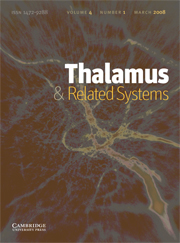Crossref Citations
This article has been cited by the following publications. This list is generated based on data provided by
Crossref.
Buzsáki, György
Geisler, Caroline
Henze, Darrell A.
and
Wang, Xiao-Jing
2004.
Interneuron Diversity series: Circuit complexity and axon wiring economy of cortical interneurons.
Trends in Neurosciences,
Vol. 27,
Issue. 4,
p.
186.
Rampp, S.
and
Stefan, H.
2006.
Fast activity as a surrogate marker of epileptic network function?.
Clinical Neurophysiology,
Vol. 117,
Issue. 10,
p.
2111.
Musizza, Bojan
Stefanovska, Aneta
McClintock, Peter V. E.
Paluš, Milan
Petrovčič, Janko
Ribarič, Samo
and
Bajrović, Fajko F.
2007.
Interactions between cardiac, respiratory and EEG‐δ oscillations in rats during anaesthesia.
The Journal of Physiology,
Vol. 580,
Issue. 1,
p.
315.
Helps, S.
James, C.
Debener, S.
Karl, A.
and
Sonuga-Barke, E. J. S.
2008.
Very low frequency EEG oscillations and the resting brain in young adults: a preliminary study of localisation, stability and association with symptoms of inattention.
Journal of Neural Transmission,
Vol. 115,
Issue. 2,
p.
279.
Rothenberger, Aribert
2009.
Brain oscillations forever – neurophysiology in future research of child psychiatric problems.
Journal of Child Psychology and Psychiatry,
Vol. 50,
Issue. 1-2,
p.
79.
Young, Calvin K.
and
Eggermont, Jos J.
2009.
Coupling of mesoscopic brain oscillations: Recent advances in analytical and theoretical perspectives.
Progress in Neurobiology,
Vol. 89,
Issue. 1,
p.
61.
Buice, Michael A.
and
Cowan, Jack D.
2009.
Statistical mechanics of the neocortex.
Progress in Biophysics and Molecular Biology,
Vol. 99,
Issue. 2-3,
p.
53.
Sitta, Elton
and
Varela, Hamilton
2010.
Beta Oscillations in the Electro-oxidation of Ethylene Glycol on Platinum.
Electrocatalysis,
Vol. 1,
Issue. 1,
p.
19.
Sitta, Elton
Nascimento, Melke A.
and
Varela, Hamilton
2010.
Complex kinetics, high frequency oscillations and temperature compensation in the electro-oxidation of ethylene glycol on platinum.
Physical Chemistry Chemical Physics,
Vol. 12,
Issue. 46,
p.
15195.
Han, Ying
Wang, Jinhui
Zhao, Zhilian
Min, Baoquan
Lu, Jie
Li, Kuncheng
He, Yong
and
Jia, Jianping
2011.
Frequency-dependent changes in the amplitude of low-frequency fluctuations in amnestic mild cognitive impairment: A resting-state fMRI study.
NeuroImage,
Vol. 55,
Issue. 1,
p.
287.
Zhang, Mei
Zheng, Chenguang
Quan, Meina
An, Lei
Yang, Zhuo
and
Zhang, Tao
2011.
Directional Indicator on Neural Oscillations as a Measure of Synaptic Plasticity in Chronic Unpredictable Stress Rats.
Neurosignals,
Vol. 19,
Issue. 4,
p.
189.
Mairena, María Ángeles
Martino, Adriana Di
Domínguez-Martín, Cristina
Gómez-Guerrero, Lorena
Gioia, Gerard
Petkova, Eva
and
Castellanos, F. Xavier
2012.
Low frequency oscillations of response time explain parent ratings of inattention and hyperactivity/impulsivity.
European Child & Adolescent Psychiatry,
Vol. 21,
Issue. 2,
p.
101.
Fingelkurts, Andrew A.
Fingelkurts, Alexander A.
Bagnato, Sergio
Boccagni, Cristina
and
Galardi, Giuseppe
2012.
Toward operational architectonics of consciousness: basic evidence from patients with severe cerebral injuries.
Cognitive Processing,
Vol. 13,
Issue. 2,
p.
111.
Glerean, Enrico
Salmi, Juha
Lahnakoski, Juha M.
Jääskeläinen, Iiro P.
and
Sams, Mikko
2012.
Functional Magnetic Resonance Imaging Phase Synchronization as a Measure of Dynamic Functional Connectivity.
Brain Connectivity,
Vol. 2,
Issue. 2,
p.
91.
Zuo, Xi-Nian
Xu, Ting
Jiang, Lili
Yang, Zhi
Cao, Xiao-Yan
He, Yong
Zang, Yu-Feng
Castellanos, F. Xavier
and
Milham, Michael P.
2013.
Toward reliable characterization of functional homogeneity in the human brain: Preprocessing, scan duration, imaging resolution and computational space.
NeuroImage,
Vol. 65,
Issue. ,
p.
374.
Karalunas, Sarah L.
Huang‐Pollock, Cynthia L.
and
Nigg, Joel T.
2013.
Is reaction time variability in ADHD mainly at low frequencies?.
Journal of Child Psychology and Psychiatry,
Vol. 54,
Issue. 5,
p.
536.
Garipelli, Gangadhar
Chavarriaga, Ricardo
and
del R Millán, José
2013.
Single trial analysis of slow cortical potentials: a study on anticipation related potentials.
Journal of Neural Engineering,
Vol. 10,
Issue. 3,
p.
036014.
Demanuele, Charmaine
Broyd, Samantha J.
Sonuga-Barke, Edmund J.S.
and
James, Christopher
2013.
Neuronal oscillations in the EEG under varying cognitive load: A comparative study between slow waves and faster oscillations.
Clinical Neurophysiology,
Vol. 124,
Issue. 2,
p.
247.
Hsu, Chia-Fen
Broyd, Samantha J.
Helps, Suzannah K.
Benikos, Nicholas
and
Sonuga-Barke, Edmund J.S.
2013.
“Can waiting awaken the resting brain?” A comparison of waiting- and cognitive task-induced attenuation of very low frequency neural oscillations.
Brain Research,
Vol. 1524,
Issue. ,
p.
34.
Watrous, Andrew J.
Lee, Darrin J.
Izadi, Ali
Gurkoff, Gene G.
Shahlaie, Kiarash
and
Ekstrom, Arne D.
2013.
A comparative study of human and rat hippocampal low‐frequency oscillations during spatial navigation.
Hippocampus,
Vol. 23,
Issue. 8,
p.
656.


